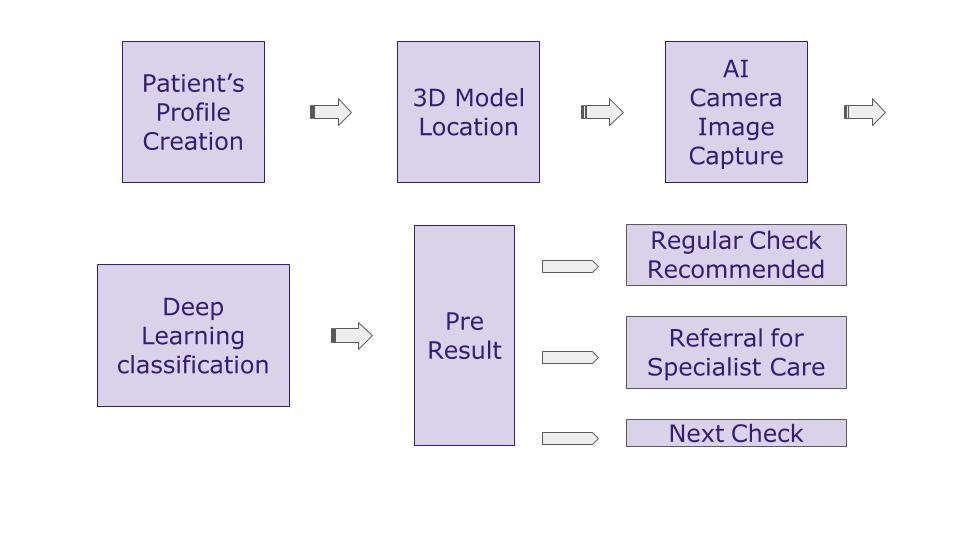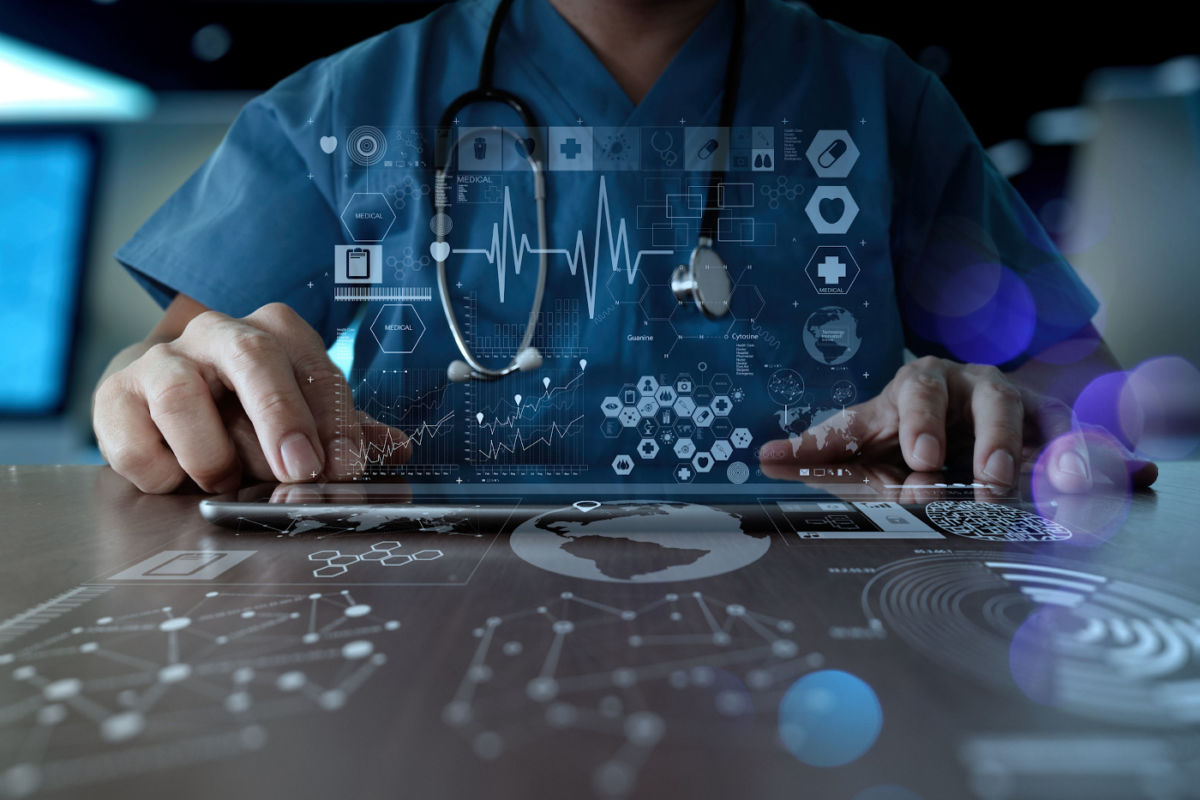Artificial intelligence has been used in health care for many years: to analyze medical images (X-rays, MRI, CT, etc.), to create expert systems and virtual medical assistants.
But however impressive it may be, AI cannot replace human experience. Ultimately, it is the doctor who determines the next steps. Artificial intelligence is a virtual assistant which can improve diagnostic accuracy and save the doctor’s valuable time.
Dermatologists have a tough job. In order to correctly determine the cause of skin disease and successfully prescribe the treatment, dermatologists monitor the entire patient’s body, evaluate its condition and, if necessary, use additional diagnostic techniques, such as biopsy.
Skinive for medical professionals.
At Skinive we see the great potential of our solution use not only by dermatologists but also by all specialists who directly or indirectly deal with skin health issues, such as cosmetologists, nurses, general practitioners, allergists, venereologists.
1. How to take off the pressure the dermatologists?
For general practitioners (therapists), it is even more difficult to determine the nature of neoplasm – as this is not their specialty. According to the statistics, about 20 percent of all the initial visits to therapists refer to skin health issues and almost all of these patients are sent to dermatologists: those who really need treatment, and those who don’t have any problems. This creates a very high workload for dermatologists. Healthy patients also take the time of a dermatologist and prevent them from concentrating on patients who need help.
2. The use of Skinive by primary healthcare specialists.
Skinive screening helps those who are not well trained on skin conditions or do not have deep knowledge in dermatology to assess the initial risks.
The Skinive Express Tests (fast-checks) allow doctors to take images of suspicious neoplasms and get a preliminary conclusion from the Skinive algorithm in 30 seconds. After you send a photo to the Skinive application, you will get a preliminary result based on the differential diagnostic method (excluding any medical condition that is not appropriate for any of the facts or symptoms that the patient may have, which should ultimately consolidate the diagnosis to a uniquely probable disease).
The differential diagnosis of the Skinive algorithm includes:
- 3 hypothetical diagnoses detected by our algorithm between the analyzed image and the database;
- Percentage of similarities detected by the algorithm for each of the variants of the assumed similarities (The higher the percentage, the better the similarities);
- Risk assessment: Low, Medium, High. Benign neoplasms – Low risk. Acne and HPV – Medium risk, neoplasms with high malignancy risk or malignant tumors – Hight risk.
- Recommendations for a specialist routing (cosmetologist, dermatologist, oncologist, etc.)
Important!
In order to avoid diagnostic errors, we recommend routing patients to a specialist in all cases where at least one of the estimated three variants indicates on a medium- or high-risk level and more than 25% of similarity detected.
3. How do we help dermatologists to examine skin?
One of the biggest problems in dermatology is the difficulty of visual diagnosis due to the absence of a large clinical case database. This is especially relevant to young professionals with a lack of medical experience.
Experienced dermatologists are exceptionally good at finding potentially dangerous skin tumors that stand out in the background of others, but it can be difficult to track changes (if there are any). Skinive provides dermatologists with a tool for the rapid tumors mapping and the use of this data for observation over time.
Skinive AI will help you to improve your medical practice with a wide array of benefits:
- Patients management: quick patients profile creation and user-friendly search engine;
- 3D Skin map allows to speed up the process of documentation: it is enough to mark the location of the photographed skin area on a 3D human body model.
- Skinive AI Smart Camera makes high-quality photos with smartphones, allowing dermatologists to see and evaluate skin problems.
- Secure data storage to track changes over time and an easy and convenient way of taking notes.
- A second opinion from AI: differential diagnosis of Skinive AI allows to exclude the unsuitable facts or disease symptoms, thus, simplifying the diagnosis.
- Dermatological Atlas provides quick access to detailed disease descriptions, diagnostic methods and treatment options.
4. Carrying out Skinive photo examinations.

- Create a new Patient Profile or use Search to find an existing one;
- Mark the tested body area on the 3D body map;
- Take a snapshot of the affected skin with the Skinive app.
Keep the smartphone camera at the right angles. Center the object. Maintain a minimum focal distance (10-15 cm) from the object. Use zoom if necessary; - Get a preliminary report from the top 3 results: the higher the Top – the higher the probability of this particular pathology. For dermatologists and oncologists, there is a possibility to choose the most reliable result from three proposed variants, or to choose another nosology from the additional list if it does not appear in the proposed Top 3 list;
- After choosing the desired nosology, the result will be saved in the application.
The result of the photo examination includes:
- patient data and time of photographic examination;
- original photo with a neoplasm, the segmented area image with a lesion and a visualization of the dysplasia level;
- Class and type of nosology: presumed diagnosis and reference to an article on a given nosology in a dermatological atlas;
- Risk Level (High, Medium, Low);
- Your comments.
You can change the probabilistic diagnosis after having the results of the additional diagnosis (biopsy). If the risk of the disease is low but the observation over time is required – schedule the next photo-examination.
How does Skinive analyze images?
Skinive uses a deep machine learning algorithm (AI-algorithm). The human ability to learn from examples and experiences has been transferred to a computer. For this purpose, the neural network has been trained using a dermoscopic imaging database containing tens of thousands of examples that have confirmed diagnosis and assessment by dermatologists.
The AI is able to distinguish between benign and malignant tumors, similar to the ABCDE rule (5 main signs of oncology: asymmetry, boundary, color, diameter, and change over time). The difference between them is that the algorithm can analyze thousands of features, but not only 5 of them. Of course, only a machine can detect that amount of evidence.
Due to the productive cooperation with doctors, the quality of the Skinive algorithm performance is constantly being improved. Based on growing experience and its own autonomous rules, the AI is able to distinguish between benign and malignant tumors, find risks of human papillomavirus, and classify different types of acne…
Use Skinive in your medical practice and join Skinive network!
